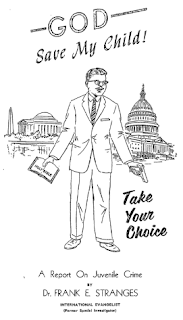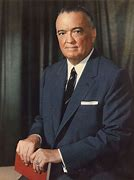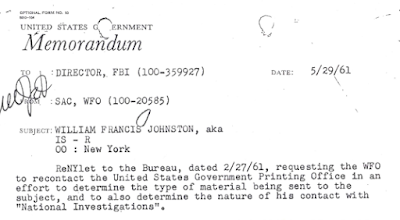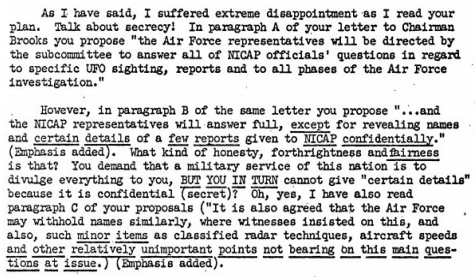Below is an excerpt from Chapter 10 of WAYWARD SONS: NICAP and the IC. The excerpt explores the efforts of Maj. Donald Keyhoe and his National Investigations Committee on Aerial Phenomena to generate Congressional hearings on UFOs during the 1960s. There are many similarities to events happening in today's overlap of politics and UFO advocacy. While Keyhoe's efforts may have initially appeared successful, his lobbying may arguably serve as more of a cautionary tale than cause for celebration.
NICAP files contain reference to what the organization considered “educational work” conducted in
1962. During the first quarter of the year, “special material” was sent to 62 students and teachers for what
was described as use in preparing term papers, science projects, research reports, and so on (NICAP_Educational_work.pdf, p1). Such
material included “a bibliography, source material,
back magazines, etc.” More shipments for the fall
were reportedly being processed.
Similar efforts to “educate” Congress were also
undertaken, as indicated in a 1962 form letter apparently authored by Keyhoe (NICAP_Educational_work.pdf, p9):
We can observe Keyhoe's tactic of declaring
UFOs represented a national security threat. This
would hold obvious significance to elected officials and intelligence agencies. Perhaps, however, applying the term “UFO” to such potential threats was not
as relevant as UFO proponents might prefer the public believe. Beyond groups like NICAP using the issue
as a public relations ploy, it's not clear how the armed
forces should do its job any differently if it called air incursions UFOs instead of radar returns. Similar circumstances may be observed today.
Keyhoe previously ran into resistance on such
matters. Rep. Joseph Karth, in a 1961 letter to Keyhoe, addressed Keyhoe's proposal for a Congressional hearing. Karth wrote (NICAP_Keyhoe_Karth.pdf, p3):
Rep. Karth expressed disappointment in Keyhoe's apparent intention to focus on Air Force secrecy
as compared to presenting substantial evidence of
UFOs. It has since become an all too standard part of
the ufologist tool kit to plead their cases based on the
obstruction of evidence rather than its presentation. Furthermore, Karth suggested he questioned
Keyhoe's arrogance and hypocrisy concerning national security and secrecy. The Congressman appeared
perturbed Keyhoe seemed oblivious to the sensitivity
of classified material, referring to it as “minor items,”
while expecting to be granted the luxury of withholding information as he saw fit. This of course became a
staple of the UFO genre, and it continues today. Such
concealed details frequently obstruct fundamental aspects of the universally recognized fact-finding
process. The double standards try the patience of the
more discerning members of the community at large.
Rep. Karth was apparently in the “put up or shut up”
camp, and saw the irony in Keyhoe reserving the right
to remain silent while demanding answers from men
charged with protecting national security.
 |
| Richard Hall |
Nonetheless, as noted in the above 1962 letter
penned by Keyhoe, The UFO Evidence was on its
way. It was destined to be considered among NICAP
and editor Richard Hall's most significant contributions
to the study of UFOs. From a July 1, 1964 NICAP
press release (NICAP_papers_mixed_years.pdf, pp32-33): “A documentary report charging Air Force censorship of unidentified flying objects was submitted today to Congressman John McCormack, Speaker of
the House, and Senator Mike Mansfield, Majority
Leader. The report is based on a 7-year investigation
by military and technical experts of the National Investigations Committee on Aerial Phenomena (NICAP).
“The 184-page document, titled 'The UFO Evidence,' contains hundreds of verified UFO sightings
by airline and military pilots, aerospace scientists and
engineers, and other experienced observers.
“NICAP, a private fact-finding organization, includes on its Board of Governors and Advisers: Army, Navy and Air Force officers, scientists, veteran pilots,
and other specialists...
“The charge of official secrecy was backed by
a majority of the Board and Advisers, including
Colonel J. Bryan III, USAFR (Ret); Admiral H. B.
Knowles, USN (Ret); Dr. Leslie K. Kaeburn, biophysicist, University of Southern California; and Dr. C. P.
Olivier, President of the American Meteor Society...
“The NICAP Report covers approximately 750
cases selected from over 5000 on file. The documented cases include numerous reports by Air Force pilots, and incidents of UFOs which made close approaches to aircraft... According to NICAP, the large
majority of these cases are totally unsolved. Although
Air Force analysts claim to have explained some of
the cases, NICAP says counter-to-fact answers have
often been given to Members of Congress and the
press...
“After the current outbreak of UFO sightings,
the Air Force admitted it had 910 unsolved cases out
of 8128 - approximately 11%. Heretofore the Air Force
had insisted it had solved all but 1 or 2%. The most
recent unexplained sighting, according to the Air
Force, is the April 24 observation by a police officer in
Socorro, N.M., who saw an egg-shaped UFO take off
from a gulley. Imprints and scorch marks were found
at the site.
“The NICAP report states '...it is a reasonable
hypothesis that the unexplained UFOs are real physical objects... artificial... under the control (piloted or
remote) of living beings'... Many of the NICAP Board
Members and Advisers have gone further, contending
that the UFOs are extraterrestrial devices observing
the earth. Among these are Col. J. Bryan III; Admiral
H. B. Knowles; Prof. C. A. Maney; Dr. Leslie K. Kaeburn; and Capt. William B. Nash.
“Verified cases in the report show speeds and
maneuvers beyond the capabilities of any earth-made
machines, often confirmed by radar... In addition to
the massive U.S. evidence, NICAP reports dozens of
foreign cases from trained observers which confirm
the observations of high performance objects and
lead to the same conclusion.
“In order to reduce the dangers of accidental
war caused by misidentification of UFOs on radar
screens, and to educate the public to the realities,
NICAP advocates a sweeping review of government
policies on the subject by Congress. Speaker McCormack and Senator Mansfield have been asked to request UFO hearings. Many Members of Congress in
recent years have gone on record in favor of open
hearings...
“In releasing the document, NICAP warned that
crackpot groups might try to take advantage of it by
claiming it supports their views. The Committee disowned any claims that UFOs proved any particular religious or philosophical views currently being expounded by UFO cults. NICAP stated it had not found
verification of a single claim of communication with
space men.”
NICAP would indeed eventually see its hopes
come to fruition for a Congressional hearing on UFOs,
but before that happened, CIA officers paid a visit to
NICAP headquarters. A now publicly available CIA memo dated January 25, 1965, reflects Agency interest in obtaining materials, including UFO reports, from
NICAP for delivery to its Office of Scientific Intelligence (OSI). The memo further states OSI desired
the information to assist in preparing a paper on
UFOs.
The CIA Contact Division met with Richard Hall
on January 19, 1965, at which time he loaned the dispatched officers material and UFO reports for review.
It was noted in the January 25 CIA document there
was a strong feeling on the part of NICAP officials that
the Air Force tended to downgrade the importance of
UFO sightings. Hall apparently told the CIA officers
there had been instances where the Air Force attempted to intimidate witnesses and get them to sign
false statements.
In closing, the report stated a security clearance was being requested on Hall. There are various
accounts and anecdotes around the UFO community
about Hall's interactions with intelligence agencies, often framed as Hall having a rather nonchalant attitude
about them. A generally accepted consensus is Hall
was never issued a security clearance and did not develop a significant relationship with the CIA, and I
have not discovered any particular reasons to suppose otherwise.
A now declassified OSI memo is dated January
26, 1965. You will note it was apparently composed
the day after the above memo was written. The OSI
memo was sent to the Director of Central Intelligence
from OSI Assistant Director Donald F. Chamberlain. It
was written in response to a request from DCI John
McCone for an assessment on UFOs. The materials
borrowed from NICAP contributed to findings reported
by Chamberlain in the memo, according to the CIA.
Chamberlain summarized some then-recent
UFO reports, adding no evidence was revealed UFOs
were of foreign origin or were a security threat to the
United States. He clarified OSI monitored UFO reports, including those investigated by the Air Force,
and concurred with Air Force conclusions.
Ironically, while Keyhoe and his supporters
were convinced an orchestrated UFO cover-up was
being perpetrated by the CIA and Air Force, the two
agencies were apparently actually in agreement there
was not even a threat, at least not from unknown airborne objects. Threats of propaganda and espionage
were another story, as suggested previously by the
Robertson Panel. An argument could be made such
concerns, and the resulting minimization of the topic
for what may have been considered in at least some
instances the public's own good, contributed significantly to the perception of official UFO secrecy.
Similar might be said about the intelligence
community's aversion to publicly addressing UFOs
due to reasons that included its own manipulation of
the topic in an offensive capacity. Uncle Sam obviously did not want to address his own covert use of the
UFO subject.
There was additional irony in the way UFO enthusiasts tended to interpret CIA interest in NICAP.
For instance, NICAP and Keyhoe chose to withhold
certain information because they did not want to divulge sources of reports and documents. They subsequently feared the CIA was snooping around to infiltrate their lines of communication. That may have
been true to some extent, but not for the reasons
NICAP chose to believe, which hinged upon the perception the CIA was scrambling to keep the existence
of an extraterrestrial presence from becoming publicly
revealed.
In a manner of speaking, NICAP activities and
subsequent CIA responses served as a self-fulfilling
prophecy for NICAP. Intelligence community actions
often seemed to be interpreted to confirm what UFO
investigators chose to subjectively believe, and that
largely continues to be the case in the UFO genre today.
* * *
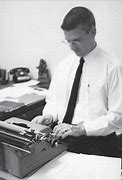 |
| Gordon Lore |
Gordon Lore explained it was during this point
in time he began working at NICAP. In his book Flying
Saucers from Beyond the Earth, Lore stated he had
taken a job as a writer-editor in Washington, D.C. In
addition to writing, the future NICAP assistant director
was also a musician who played the guitar at night at
a local coffee house. Richard Hall was in attendance during one of
Lore's performances in the summer of 1965, Lore
wrote. He accompanied Hall and a group of friends
back to Hall's apartment where they hung out and
Lore entertained some more. Lore told Hall about his
interest in UFOs, and was hired to join NICAP by the
end of the night. He soon submitted his resignation at
what he described as a subsidiary of U.S. News and
World Report and was on his way to work with Keyhoe, Hall and NICAP.
“It was to become a dream job,” Lore wrote,
“mixed with more than a little anxiety about keeping
the organization afloat during the next five years.”
In 1966 a series of dramatic UFO sightings began in Michigan. The widely reported events included
dozens of witnesses, as well as police officers giving
chase to whatever they were seeing in the sky.
Renowned UFO investigator J. Allen Hynek infamously suggested swamp gas as a feasible explanation.
Then-House Minority Leader and future-President Gerald Ford took interest. As an elected official
of Michigan, he was among those supporting calls for
a Congressional hearing on UFOs. The House Armed
Services Committee soon conducted just such a hearing, although it was relatively brief. While there wasn't
much in the way of substantial information getting revealed, a chain of events was by that point in motion
that would forever shape the timeline of UFO World.
The Air Force announced a forthcoming independent review of Project Blue Book and related UFO
evidence. It was titled the University of Colorado Scientific Study of UFOs, conducted by what was known
as the Condon Committee due to the lead researcher,
physicist Dr. Edward U. Condon.
Richard Hall described events of 1966 and how
they influenced NICAP in his previously referenced
1994 paper, The Quest For The Truth About UFOs: A Personal Perspective On The Role Of NICAP. With a
little help from the UFOs, Hall explained, NICAP was
thrust further than ever into the media spotlight. As a
result of all the buzz, NICAP was deluged with mail,
routinely receiving hundreds of letters a day. Public interest in UFOs, and subsequently NICAP, produced a
degree of financial stability previously unknown to the
organization.
Don Berliner reported that by early 1967
NICAP grew to some 14,000 members. The Committee then employed nine full-time staff, which, Berliner
noted, was more than could be said for the Blue Book
payroll.
Hall wrote that NICAP worked diligently to provide Dr. Condon and his staff with the best evidence
possible to assist in compiling its report. NICAP understandably saw the UFO study undertaken at the
University of Colorado as significant, or, as Hall put it,
that their dreams were coming true. The help was enrolled of Dr. James E. McDonald, an outspoken UFO
proponent and atmospheric physicist at the University
of Arizona. Many UFO proponents probably fully anticipated a desirable outcome, at least initially, because they sincerely believed the evidence did indicate an abundance of interplanetary craft. Intelligence
agencies and other scientists, not so much.
In his 1973 book, Aliens From Space, Maj.
Keyhoe stated NICAP eventually compiled some
9,300 UFO cases, 2,000 of which he suggested were
top notch. I guess he was suggesting there were
aliens all over the place. Perhaps it did not occur to
Keyhoe that overwhelming Condon and the public in
endless stories might not be as effective a tactic as he
hoped.
Hall wrote NICAP “worked on a massive
project of copying files for the Colorado scientists.”
This went on for over the course of a year and included “hundreds of strong cases,” as well as NICAP subcommittees sending Condon new reports perceived
as potentially important.
Keyhoe further wrote that almost right away
Condon and the project administrator, Robert J. Low,
began indicating to the press they did not anticipate
arriving at conclusions supporting anything overly significant about UFOs. The two were quoted as speaking favorably about Air Force investigative efforts, as
well as suggesting the government should get out of
the UFO business. Such positions were of course in
conflict with stances held by NICAP.
In spite of the statements, Keyhoe and NICAP
tried to stay the course. That might have particularly
been due to repeated assurances received from Condon and Low the study would be conducted objectively, according to the writings of Keyhoe and Lore. Dr.
Condon and Robert Low reportedly minimized the significance of their published remarks when asked
about them by Keyhoe.
The final straw came for Keyhoe when he
learned of what came to be known as the “Trick
Memo.” It was a leaked Condon Committee memo
written by Robert Low in which he described an operating strategy for the UFO study. The committee
would consist of scientists, Low explained, who could
not possibly prove a negative result, even though they
might indeed publish an impressive body of evidence
suggesting there was nothing extraordinary about
UFO observations. Low then added, “The trick would
be... to describe the project so that, to the public, it
would appear a totally objective study, but, to the scientific community, would present the image of nonbelievers trying their best to be objective but having an
almost zero expectation of finding a saucer...” (Lore, Gordon. 2018. Flying Saucers from Beyond the Earth.
BearManor Media. (p124))
Keyhoe and his organization, when they got
wind of the memo, responded with an April 30, 1968
press release, “NICAP Calls Colorado UFO Project
Failure” (NICAP_incorporation_papers.pdf, p31). The release stated NICAP sent a report to
the president of the United States, containing evidence of “grave deficiencies” in the University of Colorado UFO project. It was further stated NICAP broke
relations with the project after 17 months of cooperation. Reasons listed for the break included Condon
had never conducted a field investigation of a UFO
sighting or interviewed responsible witnesses, although named as chief principal investigator.
“Dr. Condon summarily discharged two Project
scientists,” the news release continued, “for revealing
written proposals by Project Coordinator Robert J.
Low that the Colorado Project be represented to the
public as 'totally objective', when in fact it would be
constituted almost entirely of non-believers, with 'an
almost zero expectation of finding a saucer'.”
It was further alleged Condon and Low “both
refused, in writing, to answer NICAP questions as to
whether the Project was being conducted in a biased
and negative manner.” Condon, it was asserted, “refused to guarantee he would examine any of the hundreds of NICAP-investigated UFO reports, submitted
at the Project's request.”
Keyhoe and NICAP took measures to prepare
for public response to what was clearly going to be,
from their perspectives, an unfavorable report from
Condon. Their efforts included a second Congressional hearing, organized by NICAP supporter Rep. J. Edward Roush, an Indiana Congressman who chaired
the House Committee on Science and Aeronautics.
He held the Symposium on Unidentified Flying Objects on July 29, 1968.
While a few qualified scientists and NICAP representatives attended and provided testimony, the
event was limited in scope. It did, however, mark the
historic occasion of a second Congressional hearing
on UFOs.
* * *
The Condon Report was published in January
1969. The general conclusion stated nothing had
come from the study of UFOs that added to scientific
knowledge. It was additionally reported, “Careful consideration of the record as it is available to us leads
us to conclude that further extensive study of UFOs
probably cannot be justified in the expectation that
science will be advanced thereby.”
The issue was addressed in the document as
to what, if anything, the federal government should do
about UFO reports received from the general public.
“We are inclined to think that nothing should be done
with them in the expectation that they are going to
contribute to the advance of science,” the Condon
Committee wrote.
If the implications were not clear enough as to
what the group collectively recommended about operating government UFO research projects outside normal military channels, it explicitly clarified its stance.
“It is our impression that the defense function could
be performed within the framework established for intelligence and surveillance operations without the
continuance of a special unit such as Project Blue
Book, but this is a question for defense specialists
rather than research scientists.”
The Condon Committee made its position
clear: The study of UFOs was producing nothing of
scientific value and Blue Book should be discontinued.
* * *
The report, eagerly anticipated by the public,
was now actually published. Gordon Lore wrote a
memo to the NICAP office in the aftermath. The January 27, 1969, memo declared the organization and
the UFO subject were facing perhaps their most critical period. Refuting the Condon Report was crucial
and would require cooperation and hard work on the
part of NICAP, Lore suggested (NICAP_Condon_reaction.pdf, p1). Time would show
the goal was not to be achieved.
Challenges included quarrels among the staff
and a declining membership. If the negative Condon
Report wasn't bad enough, it had now been over two
full years since the Michigan sightings. People were
tired of waiting for answers, or at least the answers
they wanted to hear. What's more, a growing number
of NICAP supporters' patience was wearing thin about
attacking the Air Force.
As explored earlier, it is difficult to tackle the
UFO subject without drawing lines in the political
sand. This was not only true in Keyhoe's day, but was
the case for years to come. As I write this, current
news cycles are more likely to include statements
about UFOs from Pentagon spokespersons, Senators, and bureaucrats than from scientists. We should
take that into deep consideration when forming our
assessments. We might also question what practical
contribution Congress might even make to the topic of
UFOs. In hindsight, much of it seemed to be performative and in pursuit of a mixed bag of agendas.
 |
| Maj. Donald Keyhoe |
In the case of Keyhoe, he seemed to have
come to believe lobbying elected officials and leveling
demands at intelligence agencies was UFO research.
At the least, it appears he considered it the most likely
way to produce substantial results. If his actions were
indicative of his beliefs, and he truly thought he was
pursuing the most productive path, he was simply
wrong. He gave it a hell of a try, though, for what that
may or may not be worth. Many at the time seemed to believe the Condon Report was part of an orchestrated cover-up to
deny the reality of UFOs and ultimately the extraterrestrial presence the reported craft were often believed to indicate. More than a few still think so, at
least among those in UFO circles who are aware of
the Condon Committee. Frankly, I doubt many people
could tell you why they believe the study was a sham,
the idea just took on the quality of one of those “everybody knows” kind of things.
I strongly suspect very few people could articulate such circumstances as the Trick Memo and offer
specific reasons why they believe the Air Force and
Condon Committee conspired to deceive the public
and cancel Project Blue Book. In most circumstances,
the primary reason for such beliefs seems to be because UFOs were not confirmed to be sensational,
thus there must have been a government cover-up.
Perhaps there actually were more deceptive
motives at play. It's possible, for any number of reasons. It's also possible the Air Force came to conclude chasing UFOs was a waste of time much more
often than not, and Condon and Low were subsequently identified as good candidates to arrive at such
a conclusion.
It's a reasonable likelihood Air Force officials
sincerely found UFOs and the related controversies to
be an unproductive drain of resources, and believed
objective scientists would concur – as had often been
the case up to that point. The powers that be may
therefore have identified a somewhat “fixed” study as
the best way out of the problem. It may not have been
they were trying to rig the study as much as they were
trying to ensure it did not fall under the care of overly
enthusiastic saucer fanatics.
It could even have been the intent, at least in
part, for the Condon Committee to upstage NICAP,
and create an alternative group of respected scientists and researchers. The alternative group would, of
course, reach different conclusions than those promoted by NICAP. In the process, it would ease the Air
Force burden of answering questions about UFOs
and constantly finding itself in the crosshairs of Donald Keyhoe.
* * *
Richard Hall did not seem to subscribe to conspiracies about the Condon Committee. That was the
case even though he was admittedly bitter over circumstances surrounding his August 1969 final departure from NICAP. He described negotiations as long
and contentious with Board members Col. Joseph
Bryan III and Joseph B. Hartranft, Jr. Hall wrote the
conflict was over back salary issues and stated the
negotiations ultimately went nowhere.
Hall extensively supplied information to the
Condon Committee, as well, which stood to substantially increase his disappointment about the resulting
report and overall circumstances. Nonetheless, he did
not promote the Condon cover-up angle.
“Was the Colorado UFO Project a conspiracy
to debunk the subject?” Hall wrote in 1994. “Another
'front' operation to sweep the UFO problem under the
rug? Many UFOlogists today write it off in that way,
assuming that it must have been a put-up job from the
start. However, there is a much simpler and all too-human explanation for what happened.”
Condon and Low were simply not interested in
UFOs, Hall suggested. Hall wrote that during one
briefing he attended, Condon fell asleep.
In another instance, Hall explained he personally hand-carried to Condon what he felt was an impressive and thick investigation report on a 1966 UFO
case. When the Condon Report was later released,
Hall was astonished to find no mention of it at all.
“It had never occurred to me,” Hall explained,
“that he would simply ignore it.”
In his previously referenced 2018 book, Gordon Lore reflected, “Following the public release of
the Condon Report, the prospects for NICAP continuing as a viable UFO organization quickly took a downward spiral. Adding fuel to the fire, unfortunately, was
Keyhoe himself. Being an organizational and money
manager was not his cup of tea. Some had even compared him to 'a second Townsend Brown.'
“In a secret meeting on December 3, 1969, the
NICAP Board with Colonel Joseph Bryan III presiding,
fired both Keyhoe and myself. It soon became apparent that I had to be terminated as a convenient
'scapegoat.'” (Lore, Gordon. 2018. Flying Saucers from Beyond the Earth. BearManor Media. (p237))
And like that, the Keyhoe years were over.
Staffer Stuart Nixon became director, and John
“Jack” Acuff was soon appointed president. Ted
Bloecher recalled the circumstances in a letter written
to Richard Hall in approximately 1973. He was initially
referencing his own business disagreement with
Nixon, as compared to those concerning Keyhoe and
Lore, when he wrote, “I have underestimated the
lengths Stuart is capable of going to. But then, he's
the one who fixed it so Major Keyhoe and Gordon
Lore got axed. The shame of it is, I went along with
it.” (NICAP_Bloecher_Report_1947.pdf, p5)





